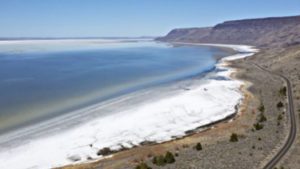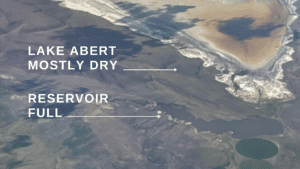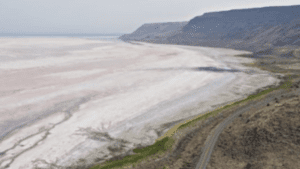Author: Ryan Houston | Published: May 5, 2022 | Category: Deep Dive
Lake Abert was catapulted onto the front pages in January when in-depth reporting by The Oregonian exposed a series of missteps that contributed to the problems now facing this imperiled ecosystem and the hundreds of thousands of migratory birds that depend on it.
Local news media also covered the issue, with the Lakeview Examiner declaring “State inaction could permanently destroy Lake Abert.”
If inaction contributed to the problems we have today, it may come as no surprise that we need action to get on track with a long-term conservation solution for the lake.
But what are those actions? Here’s ONDA’s take.
To help catalyze efforts to protect this often overlooked lake in the desert, ONDA teamed with local, state and national partner organizations to send a letter to Oregon’s Governor Brown and key state agencies urging immediate action to restore Lake Abert. This was followed by letters to the Governor and state legislators signed by more than 550 ONDA members echoing these concerns.
In response to the wave of media coverage and these direct requests, the Oregon House Committee on Agriculture, Land Use and Water held an informational hearing in February to learn more about the situation at Lake Abert. This was an important step as it reflected legislators’ focus and attention on the need to conserve Lake Abert.
Throughout this spring, we have continued to encourage the State of Oregon — including the Oregon Water Resources Department, Department of Fish and Wildlife, and Department of Environmental Quality – to work together under the leadership of the Governor’s office to take several specific, near-term steps to help save Lake Abert.
Some of the important initial steps are:
Monitor and measure stream flows, groundwater levels, lake levels and water use.
The old adage “you can’t manage what you don’t measure” applies at Lake Abert, just as it does throughout the arid West. For many watersheds – and aquifers – in central and eastern Oregon, the State does not have good data on water availability and water use to make fully informed management decisions. [See “Draining Oregon” and “Race to the bottom: Draining Summer Lake.”] This has been a long-standing problem for Lake Abert as some of the most basic information about lake levels, inflows to the lake and upstream water management has not been regularly collected.
The state needs to establish a comprehensive program for conducting foundational monitoring and measurement of water in the watershed. While there are some technical challenges to overcome because it can be surprisingly difficult to accurately measure water in this kind of system, state agencies have the core capacity, expertise and authority to establish a robust monitoring and assessment program. The state can also tap into additional support and expertise from federal partners like the U.S. Geological Survey, as well as federal funding that may become available through important legislation like the Saline Lakes Act, sponsored by Oregon Senators Jeff Merkley and Ron Wyden among others.
The State has indicated they are working on improving data collection and we’re hopeful that real progress will be made in 2022. Basic measurement and monitoring are essential for developing a clearer picture of the problems facing Lake Abert and, as importantly, for developing and implementing long-term solutions for conserving the ecosystem.
Develop and apply for instream water rights.
Under Oregon’s Instream Water Rights Act of 1987, the State may establish “instream water rights” to protect water instream for fish, wildlife, habitat, water quality and other important public benefits. Instream water rights are not only for streams as they can also be used to protect lakes. While any new instream water rights established today would be junior to previously-established rights (and therefore not affect anyone who currently has valid water rights), instream water rights are important for defining how much water is needed to sustain Lake Abert and then setting the stage for potential future voluntary instream flow restoration projects that would benefit the lake.
The establishment of instream water rights over the past few decades has helped define and ultimately support important streamflow restoration and conservation outcomes, with success stories available from many communities and watersheds across the state. While significant streamflow restoration efforts are likely years in the making, there’s no better time than the present to get started with the basic building blocks like State-adopted instream water rights.
Follow through on permits for the reservoir.
The Oregonian articles offer a deep-dive description of the complex history of the reservoir and its permitting process under state and federal regulations. We won’t attempt to repeat those details here but the key point is that the State of Oregon made several very specific recommendations and commitments to ensure the reservoir would not harm Lake Abert when the reservoir project was first approved by the State in the early 1990s. These were robust, well-considered requirements, reflecting thoughtful analysis, detailed study and the best available science.
Some examples of the recommendations, conditions or requirements of the Oregon Department of Fish and Wildlife, Department of Environmental Quality and/or the Water Resources Department in the early 1990s include:
- Ensuring a minimum of a 15 cubic foot per second (CFS) bypass flow below the reservoir so that some amount of water would always flow into the lake;
- Limiting water diversion from the reservoir when lake levels drop below a critical threshold;
- Proactively releasing water from the reservoir when lake levels drop below a critical threshold, and
- Re-evaluating the operations of the reservoir if/when the lake goes dry.
In spite of the tremendous amount of work and careful consideration invested developing these prescriptions, none of them have been implemented to date. More than 30 years later, we now face the crux problem these conditions were specifically intended to avoid — a full reservoir next to a dry lake.



